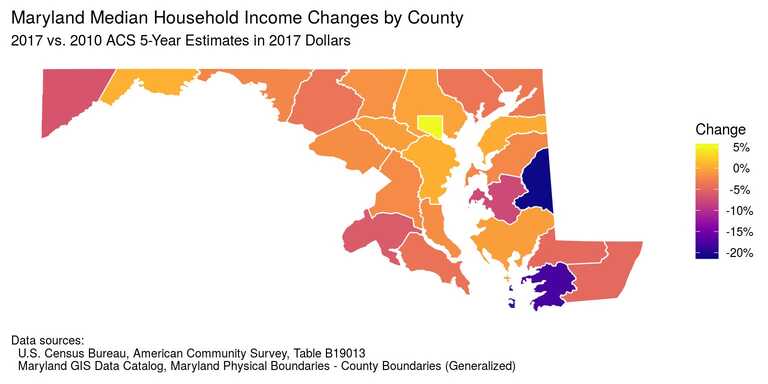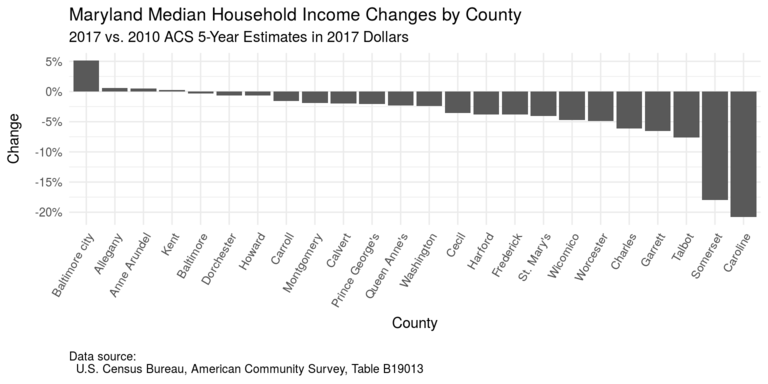UPDATE 2024/01/04: This post originally appeared on my Civility and Truth Substack newsletter. I’ve moved it to my main site in an effort to collect all of my writing in one place.
After my data analysis of Virginia counties’ household income fell apart so spectacularly (see my last post) I felt I needed to revisit the general issue of looking at county-level median household income statistics. Because I live in Maryland (not Virginia) I decided to do it with my own state instead of worrying about someone else’s.
Almost every data analysis has a “money graph” that jumps out at you as being particularly insightful, or at least particularly interesting. The map above is my candidate for the money graph for this analysis, following closely by the bar chart below.
They show the same information in two different ways: I took the US Census Bureau American Community Survey 5-year estimates for median household income for all 24 Maryland counties (including Baltimore city), and adjusted them for inflation to express everything in 2017 dollars. (2017 is the last year for which we currently have estimates.) Then I looked at the differences for each county between the 2010 5-year estimates (which actually cover the years 2006-2010) and the 2017 5-year estimates (which actually cover the years 2013-2017). (See “Maryland median household income trends by county” for the full analysis with code.)
As you can see from the bar chart above, between these two timeframes every Maryland county experienced stagnant or declining median household income except for Baltimore city, for which median household income grew about 5% in real terms. Now, admittedly Baltimore city still is not a very affluent place, as you can see in the next bar chart, showing 2017 5-year median household income estimates.
Nonetheless, given the public perception of Baltimore city it’s surprising that its median household income was growing at all over this period, much less that it outpaced every county in Maryland. Contrast Baltimore city with Somerset County, also a relatively poor jurisdiction, which saw its median household income drop about 20% between the two timeframes in this analysis.
As I think I may have mentioned previously, median household income in a city or county can increase because the people already living there get more affluent, because more affluent people move there, or because less affluent people move away—or it could be a combination of all three factors. I don’t know exactly what’s happening in Baltimore city with respect to its increase in median household income, and I’m not sure exactly what data would be needed to know more.
In any case the situation of Baltimore city brings to mind the conventional wisdom that large cities and their metropolitan areas are thriving at the expense of rural areas and smaller cities. (See for example these articles from the Washington Post and New York Times that I turned up in a quick Internet search.) That story is certainly true for DC, which I previously highlighted as having a median household income that has skyrocketed in the past thirty years, and now matches or exceeds that of Maryland.
That in turn makes me wonder: if over the next thirty years Baltimore city could see even a significant fraction of the income growth that DC has seen over the last thirty, what might that mean for the economy of central Maryland? We often think of the troubles of Baltimore city, economic and otherwise, as being irrelevant to us out in the suburbs. However, it’s possible that even the relatively modest income gains Baltimore city has seen are showing us something different: that the city is an economic engine for central Maryland, and if it could revved up even more it might pull Howard and other counties out of the relative income stagnation they’ve experienced over the past few years.
That’s all for this week. As always, if you find these posts interesting and useful please tell other people about them (feel free to forward them these emails if you’d like) and encourage them to subscribe to the Civility and Truth mailing list] themselves. In the meantime, thanks for being a subscriber and reading this post!


